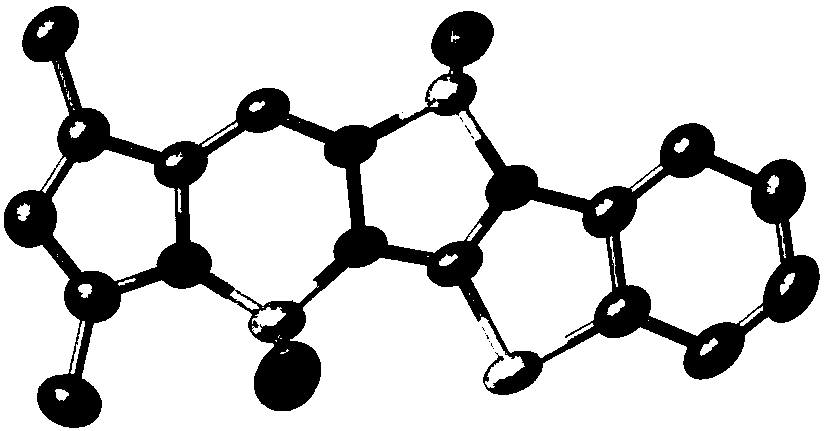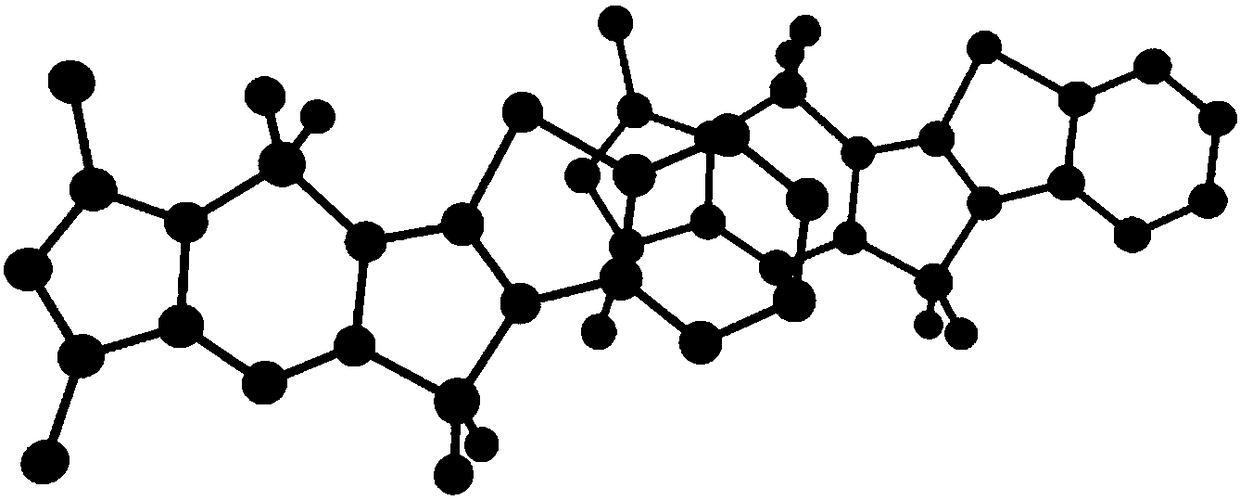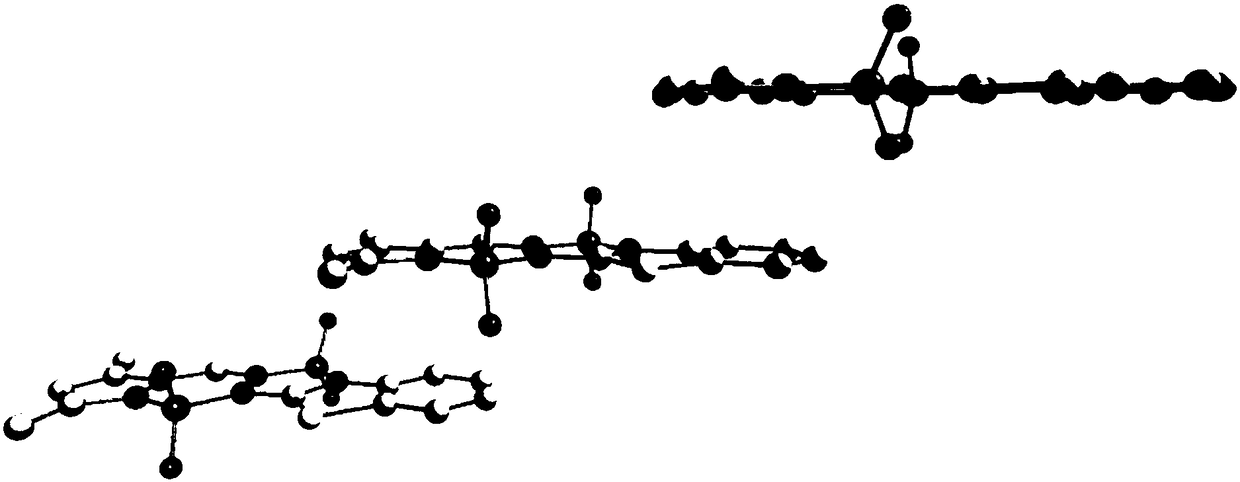Pyrrole hydrazone hydrazine difluoroboron hyperfluorescence dye and preparation method thereof
A technology of pyrrole hydrazone and fluorescent dyes, which is applied in the fields of organic synthesis and fluorescent dye preparation, and can solve the problems of limited molecular types of strong fluorescent dyes with molar extinction coefficient
- Summary
- Abstract
- Description
- Claims
- Application Information
AI Technical Summary
Problems solved by technology
Method used
Image
Examples
Embodiment example 1
[0047] Synthesis of pyrrole hydrazone difluoroboron strong fluorescent dye 1a:
[0048]
[0049] Dissolve 2-pyrrolealdehyde (190mg, 2mmol) and 2-hydrazinobenzothiazole (348mg, 2.1mmol) in 2-dichloroethane (60ml), add p-toluenesulfonic acid (87mg, 0.05mmol) . The reaction mixture was heated to reflux for 6 h, followed by TLC spot plate. When the 2-pyrrole aldehyde derivative disappears on the silica gel plate, that is, when the reaction is complete, add 2-10 mL of N,N-diisopropylethylamine into the reaction system. After the reaction mixture was stirred for 10 min, boron trifluoride ether (3-20 ml) was added, and the reaction system was stirred and refluxed for 2 h. After cooling to room temperature, the reaction mixture was transferred to a separatory funnel, and dichloromethane and water were added. The organic phase was separated, the corresponding aqueous phase was extracted several times with dichloromethane, and the organic layers were combined. Wash with water, dr...
Embodiment example 2
[0055] Synthesis of pyrrole hydrazone difluoroboron strong fluorescent dye 1b:
[0056]
[0057] The synthesis operation of 1b is the same as that of 1a in Example 1, the only difference is that pyrrolealdehyde is changed to the same equivalent of 2,4-dimethylpyrrolealdehyde (246mg, 2mmol), and the yield of preparation 1b is 23% (168 mg). 1 H NMR (300MHz, CDCl 3 ):δ=7.70-7.62(m,3H),7.50(t,J=7.5Hz,1H),7.34(t,J=7.5Hz,1H),6.18(s,1H),2.50(s,3H) ,2.32(s,3H). 13 C NMR (75MHz, CDCl 3 ): δ=149.7, 138.9, 137.5, 130.8, 128.3, 128.1, 124.9, 123.1, 118.2, 115.1, 14.1, 11.0. 19 F NMR (470MHz, CDCl 3 ):δ=-144.4(d, J=27.3Hz, 1F), -144.5(d, J=26.8Hz, 1F), -146.9(d, J=18.3Hz, 1F), -147.0(d, J= 18.8Hz,1F).HRMS(APCI)Calcd.For C 14 h 12 B 2 f 3 N 4 S[M-F] + :347.0921, found 347.0948.
[0058] And the spectral properties of 1b in different solvents were detected, and the test results are shown in Table 2:
[0059] Table 2
[0060]
[0061] In Table 2: λabsmax is the maximum ab...
Embodiment example 3
[0063] Synthesis of pyrrole hydrazone difluoroboron strong fluorescent dye 1c:
[0064]
[0065] The synthesis operation of 1c is the same as that of 1a in Example 1, the only difference is that pyrrolealdehyde is changed to the same equivalent of 2,4-dimethyl-3-ethylpyrrolealdehyde (304mg, 2mmol) to prepare 1c The yield was 28% (220 mg). 1 HNMR (300MHz, CDCl 3 ):δ=7.69-7.60(m,3H),7.48(t,J=7.5Hz,1H),7.32(t,J=7.5Hz,1H),2.46-2.41(m,5H),2.24(s, 3H), 1.08(t, J=7.5Hz, 3H). 13 C NMR (75MHz, CDCl 3 ): δ=148.3, 137.5, 135.6, 131.3, 130.1, 128.3, 128.0, 124.7, 123.0, 122.3, 115.0, 17.2, 14.7, 12.1, 9.2. 19 F NMR (470MHz, CDCl 3 ):δ=-144.2(d, J=26.8Hz, 1F), -144.3(d, J=26.3Hz, 1F), -146.9(d, J=17.4Hz, 1F), -147.0(d, J= 18.8Hz,1F).HRMS(APCI)Calcd.For C 16 h 16 B 2 f 3 N 4 S[M-F] + :375.1234, found 375.1235.
[0066] And the spectral properties of 1c in different solvents were detected, and the test results are shown in Table 3:
[0067] table 3
[0068]
[0069] Tabl...
PUM
 Login to View More
Login to View More Abstract
Description
Claims
Application Information
 Login to View More
Login to View More - R&D
- Intellectual Property
- Life Sciences
- Materials
- Tech Scout
- Unparalleled Data Quality
- Higher Quality Content
- 60% Fewer Hallucinations
Browse by: Latest US Patents, China's latest patents, Technical Efficacy Thesaurus, Application Domain, Technology Topic, Popular Technical Reports.
© 2025 PatSnap. All rights reserved.Legal|Privacy policy|Modern Slavery Act Transparency Statement|Sitemap|About US| Contact US: help@patsnap.com



